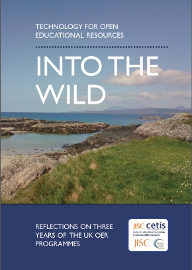There was an interesting discussion last week on the JISC-Repositories email list that kicked off after Les Carr asked
Does anyone have any experience with iTunes U? Our University is thinking of starting a presence on Apple’s iTunes U (the section of the iTunes store that distributes podcasts and video podcasts from higher education institutions). It looks very professional (see for example the OU’s presence at http://projects.kmi.open.ac.uk/itunesu/ ) and there are over 300 institutions who are represented there.
HOWEVER, I can’t shake the feeling that this is a very bad idea, even for lovers of Apple products. My main misgiving is that the content isn’t accessible apart from through the iTunes browser, and hence it is not Googleable and hence it is pretty-much invisible. Why would anyone want to do that? Isn’t it a much better idea to put material on YouTube and use the whole web/web2 infrastructure?
I’ld like to summarize the discussion here so that the important points raised get a wider airing; however it is a feature of these high quality discussions like this one that people learn and change their mind as a result, so I please don’t assume that people quoted below still hold the opinions attributed to them. (Fro example, invisibility on Google turned out to be far from the case for some resources.) If You would like to see the whole discussion look in the JISCMAIL archive
The first answers from a few posters was that it is not an either/or decision.
Patricia Killiard:
Cambridge has an iTunesU site. […] the material is normally deposited first with the university Streaming Media Service. It can then be made accessible through a variety of platforms, including YouTube, the university web pages and departmental/faculty sites, and the Streaming Media Service’s own site, as well as iTunesU.
Mike Fraser:
Oxford does both using the same datafeed: an iTunesU presence (which is very popular in terms of downloads and as a success story within the institution); and a local, openly available site serving up the same
content.
Jenny Delasalle and David Davis of Warwick and Brian Kelly of UKOLN also highlighted how iTunesU complemented rather than competed with other hosting options, and was discoverable on Google.
Andy Powell, however pointed out that it was so “Googleable” that a video from Warwick University on iTunesU video came higher in the search results for University of Warwick No Paradise without Banks than the same video on Warwick’s own site. (The first result I get is from Warwick, about the event, but doesn’t seem to give access to the video–at least not so easily that I can find it; the second result I get is the copy from iTunes U, on deimos.apple.com . Incidentally, I get nothing for the same search term on Google Videos.) He pointed out that this is “(implicitly) encouraging use of the iTunes U version (and therefore use of iTunes) rather than the lighter-weight ‘web’ version.” and he made the point that:
Andy also raised other “softer issues” about which ones will students be referred to that might reinforce one version rather than another as the copy of choice even if it wasn’t the best one for them.
Ideally it would be possible to refer people to a canonical version or a list of available version, (Graham Triggs mentioned Google’s canonical URLs, perhaps if if Google relax the rules on how they’re applied) but I’m not convinced that’s likely to happen. So there’s a compromise, variety of platforms for a variety of needs Vs possibly diluting the web presence for any give resource.
And a response from David Davies:
iTunesU is simply an RSS aggregator with a fancy presentation layer.
[…]
iTunesU content is discoverable by Google – should you want to, but as we’ve seen there are easier ways of discovering the same content, it doesn’t generate new URLs for the underlying content, is based upon a principle of reusable content, Apple doesn’t claim exclusivity for published content so is not being evil, and it fits within the accepted definition of web architecture. Perhaps we should simply accept that some people just don’t like it. Maybe because they don’t understand what it is or why an institution would want to use it, or they just have a gut feeling there’s something funny about it. And that’s just fine.
mmm, I don’t know about all these web architecture principles, I just know that I can’t access the only copy I find on Google. But then I admit I do have something of a gut feeling against iTunesU; maybe that’s fine, maybe it’s not; and maybe it’s just something about the example Andy chose: searching Google for University of Warwick slow poetry video gives access to copies at YouTube and Warwick, but no copy on iTunes.
I’m left with the feeling that I need to understand more about how using these services affects the discoverability of resources using Google–which is one of the things I would like to address during the session I’m organising for the CETIS conference in November.
